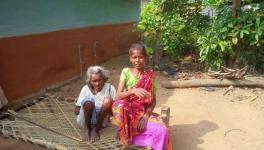West Bengal: Date Palm Jaggery Makers – a Saga of Hardships
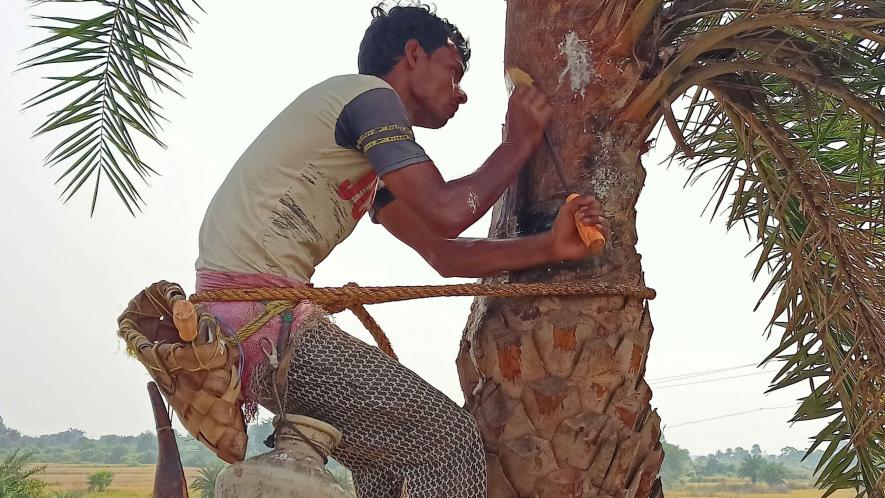
Collecting date juice from Manbazar purulia.
Every winter morning, when most people are enjoying their sleep, Khurshid Alam, Manoyar Khan, Aakash Tudu, Joydeb Bauri, Ibrahim Mallik, and thousands of other poor and marginalised people move toward date trees lining the forest path to collect date juice.
The natural juice is used to make delicious date palm jaggery. The pot, full of juice, must be removed from the tree before sunrise; otherwise, it will go bad. If that happens, the juice will not turn into jaggery. So, long before sunrise, almost in the dark, these men have to climb the dangerous thorny date trees to bring down the juice pot. Every day, twice, one has to climb and descend at least 60 date trees, each about 20 feet in height. On average, they must climb and descend 5,000 feet in these trees daily. They make date palm jaggery through immense hard work, facing the worst conditions and risking their lives every moment.
How much do we ever try to know about their daily lives and hardships?
“In the middle of the month of Kartik in West Bengal (first week of November), we leave home and move to remote villages. We collect information in advance about where the date palm trees are located. Generally, these trees do not exist in deep forests. They grow naturally in rough soil. In most places, date palm trees are far away from localities; in some places, they are seen along the roadside. We collect juice from these trees,” Alam told this writer.
He said in most cases, a verbal contract is made with the landowner where date palm trees are growing.
"One tree should normally yield 3 kilogrammes of jaggery per month in three months. In addition, the owner of the land where they make makeshift setups has to pay Rs 5,000-6,000 as rent for three months," he said.
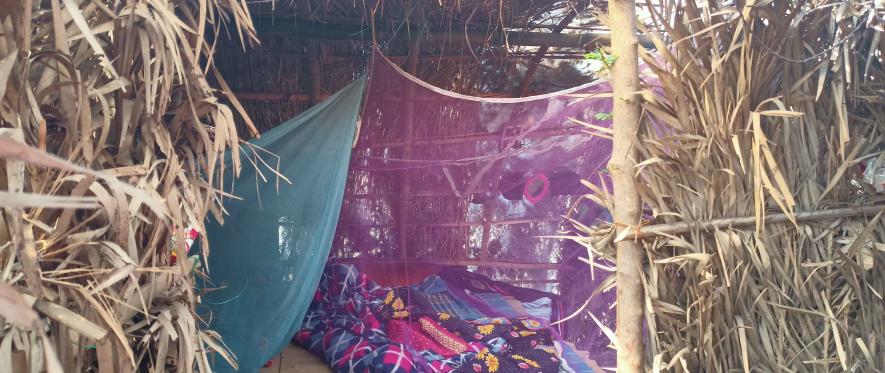
Makeshift shelter for date palm makers at Manbazar, purulia
This year, Alam has come to the Bankura Lokepur area along with his father, Mansur Ali Bhunya, and his nephew, Mursalim Dalal, 70 km away from Bankura-Hooghly border’s Gopinathpur village, to set up a mahol (date palm jaggery manufacturing centre).
Abdul Haque Mandal, along with his son Bakibul Mandal and his son-in-law Aasadul Mandal, has come to Manbazar of Purulia district from Satsagra village under Indpur Block of Bankura district, about 60 km away, to make date palm jaggery.
"About 300 families live in our village, of which nearly 250 male members have spread to different parts of Bankura, Purulia, and Jhargram districts to make date palm jaggery. Several families' working members have also started this work in Chaibasa, Dhanbad, Jamshedpur, and Chakrodharpur, all surrounding forest-based areas of Jharkhand," he said.
Mandal further stated that the economy of his village was sustained by making date palm jaggery and talpatali (palm juice cake) in the summer, because most families do not have cultivable land. The people of Satsagra village must sustain their existence through this hard physical work, he added.
Elderly Aakker Aali Mandal echoes these words.
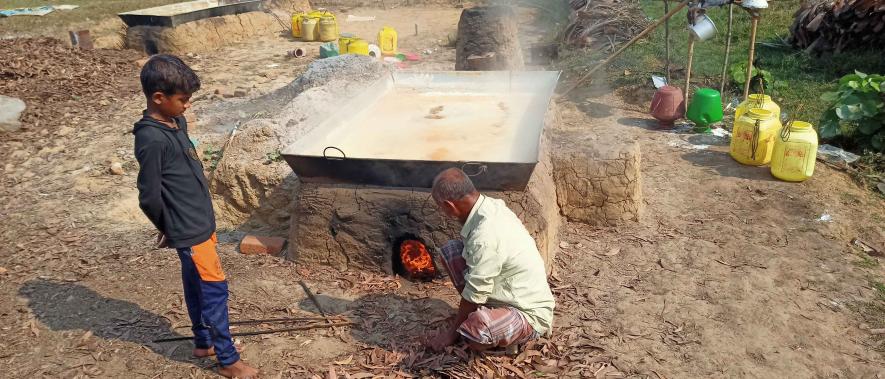
Making jaggery by elderly Aakkar aali Mondal. His grandson observed it.
“We have been doing this for generations. If we had an alternative way of earning, why would we have to go through such painful work?” he said.
The senior Mandal stated that earlier, more or less, jobs were available at the local panchayat and block level. But there has been no work in the panchayat for three years (rural job guarantee scheme - MGNREGA). They said they do not own any agricultural land.
The fact is that every year in the Jangal Mahal area of Bengal, these date palm jaggery centres are set up in various parts of the Bankura, Purulia, and Jhargram districts. Since many years, a section of the poor, marginalised Muslim community people in the remote villages of Bankura and Purulia do this work. There are about 2,000 mohals in the three districts this year.
Date palm jaggery is sold across the state and other parts of the country through traders. The taste of this juice, jaggery, and cake is unique. It is believed that consuming date palm molasses regularly eliminates the need for multivitamins. It contains all three types of sugars: glucose, sucrose, and fructose. Date molasses have a variety of nutrients, including protein, natural sugar, minerals, and vitamins such as B2, B3, C, and A1, it is said.
How is date palm jaggery made?
In mid-November, a temporary hut is first built with date palm leaves and branches of locally available trees near such locations. The workers live in these huts for three months and collect date palm juice. Their shelters are built on the side of national or state highways so that traders coming from outside to buy jaggery can easily notice them and provide transportation facilities. The workers finish this work at the end of February and leave the place.

Making jaggery at lokepur bankura
“Every centre has a charger light that is used only during dinner. We have charged these handheld lights and mobile phones from local people’s houses. People help us," Ismail Mallik, a worker, told this writer. He said he had started making date palm jaggery at Bandawan in Purulia district.
Noimuddin Midya of Sunukpahari said that mostly male members are involved in this work. Sometimes, school-going students are also engaged in this work, while women stay at home. At least three people work in one mahol. In most cases, family members do this work at the same place, so that income stays within the family. Sometimes, people work in several places for a daily wage of Rs 250.
"When we come to build mahol, we first clean the date palm tree, cut off unnecessary branches, and scrape the upper part of the trees 9-10 inches vertically. It stays in this state for seven days. Then, we shave the trunk a little and insert a wooden tube there. Plastic containers are then hung under it. The date palm juice starts collecting into the container through the tube. Every afternoon, we peel a little and insert the wooden tube,” said Mursalim Dalal of Simlapal, Bankura.
He said the next day, the pot of juice is taken down at 5 O'clock in the morning. A container has 3-5 litres of juice. The collected juice is poured into a large container and made into date palm jaggery by burning dry leaves in a clay oven under the open sky. It takes about six hours to make jaggery from juice. And it takes about seven litres of juice to make 1 kg of jaggery. One tree yields juice for three days a week. The plant is rested for the remaining four days. There are 150-200 date palm trees in a mahol. As the winter season progresses, more juice is available, and the jaggery tastes better. This year, date palm jaggery is being sold at Rs 75/kilogram in the open market.
Several date palm jaggery producers, including Khurshid Alam, Ibrahim Mallik, and Soyed Aali Mondal, said this year they were selling jaggery at the wholesale rate of Rs 50/kg. They expect the sales to be robust from mid-December to January-end. A centre usually earns approximately Rs 40,000, excluding accommodation and food expenses.
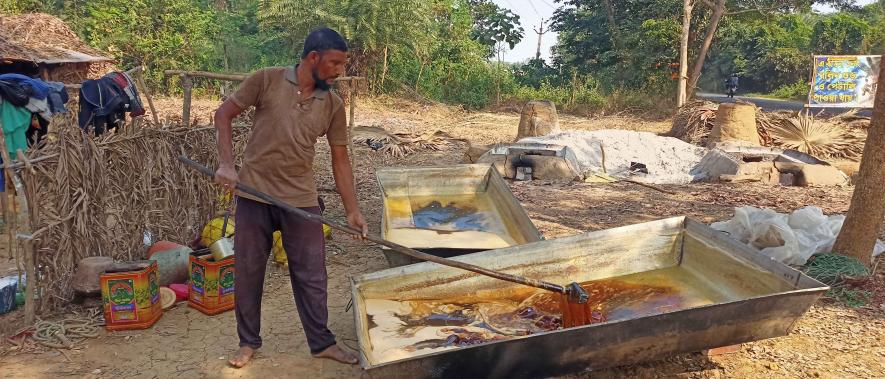
ibrahim Monadal making khejur gur ( date palm jaggery) at indpur bankura
Jaggery traders from Bankura, namely Ramgopal Modok and Mohan Agarwal, also highlighted the substantial demand for this variety of jaggery.
"We sell it at Rs 60/kg to other states. The demand for this date jaggery surges during the Pous festival in West Bengal when almost every household prepares rice cakes, typically consumed with date jaggery. This year's local festival, Makar Sankranti, was on January 14.
Despite the satisfaction of consumers, the challenging life of its jaggery makers remains unseen. Unfortunately, insufficient attention is paid to the well-being of these producers and workers and their families.
The writer covers the Jangal Mahal region for ‘Ganashakti’ newspaper in West Bengal.
Get the latest reports & analysis with people's perspective on Protests, movements & deep analytical videos, discussions of the current affairs in your Telegram app. Subscribe to NewsClick's Telegram channel & get Real-Time updates on stories, as they get published on our website.










